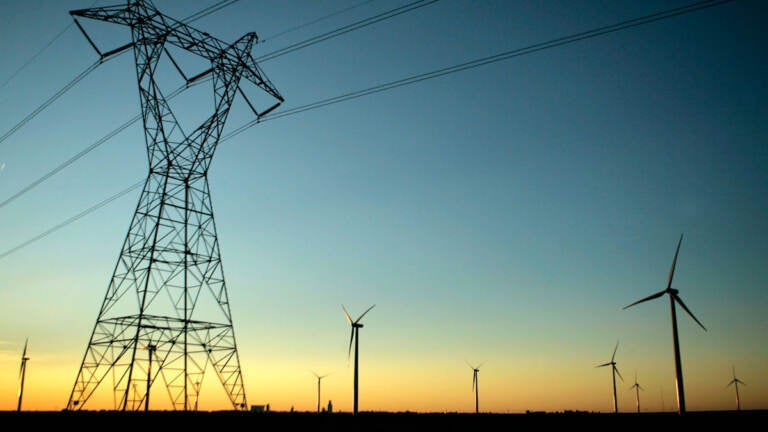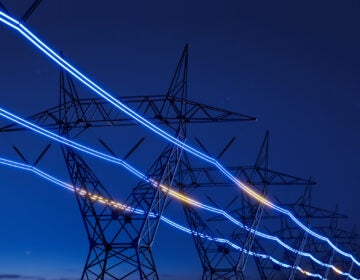Nation’s largest power grid moves to clear logjam of energy projects
If the solar projects held up in the logjam are not cleared, that jeopardizes New Jersey’s own efforts to reduce its reliance on fossil fuels.

High-voltage electric transmission lines pass through a wind farm. (AP Photo/Charlie Riedel)
This story originally appeared on NJ Spotlight.
The nation’s largest power grid took a step toward clearing up the logjam of energy projects waiting to connect to its electrical power transmission network.
PJM Interconnection is proposing a process aimed at getting thousands of mostly solar projects connected to its transmission system more quickly. That plan won overwhelming approval from more than 91% of stakeholders on Tuesday. If successful, it is designed to alleviate the connection congestion two years ahead of Oct. 1, when the plan is set to take effect.
If those solar projects now held up in that logjam are not cleared, that threatens to derail the Biden administration’s goal to have a carbon-free power grid by 2035 and jeopardizes New Jersey’s own efforts to reduce its reliance on fossil fuels.
These changes are critical for PJM to help states achieve those decarbonization goals, create the power grid needs for the future, and establish a more efficient process to handle the unprecedented influx of generation interconnections, according to Jeffrey Shields, a spokesman for PJM.
With 95% of the 225 gigawatts of generation projects in the PJM planning queue being renewable, Shields said the proposal will greatly speed up the influx of renewables to the grid and has received overwhelming support from stakeholders, including renewable developers.
It’s a compromise
During a planning committee meeting on Tuesday prior to the vote, developers generally acknowledged the proposal is far from perfect, but called it a compromise that could speed up interconnections to the PJM grid, which serves 13 states, including New Jersey and the District of Columbia.
PJM’s proposal would better prioritize projects that are most ready for construction, and streamline and accelerate the process. Some developers, however, objected to provisions in the plan that will pause the review of certain projects.
In New Jersey, solar developers also are facing delays in getting their projects connected to the power grid. The New Jersey Board of Public Utilities is holding a proceeding to fix the problem but has yet to reach a consensus with stakeholders. The interconnection problem is most severe in South Jersey in Atlantic City Electric’s territory, but growing in other electric utilities’ territories, according to clean-energy advocates.
Solar energy is a key component of the Murphy administration’s plan to transition to clean energy. By 2050, the state’s Energy Master Plan envisions that solar panels will produce 37% of New Jersey’s electricity.
The PJM proposal has multiple steps to go through the stakeholder process after clearing its planning committee. It goes before the markets and reliability committee next month and then the members committee in April. PJM hopes to file the proposal with the Federal Energy Regulatory Commission in May.
WHYY is your source for fact-based, in-depth journalism and information. As a nonprofit organization, we rely on financial support from readers like you. Please give today.






